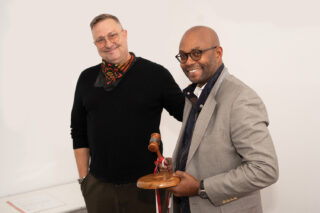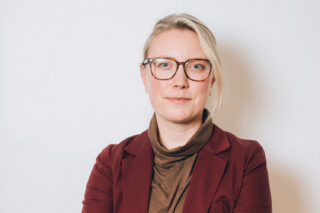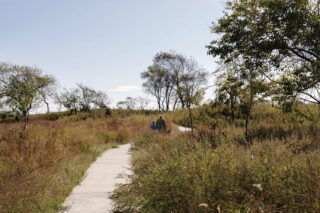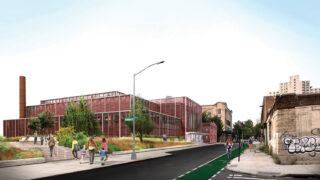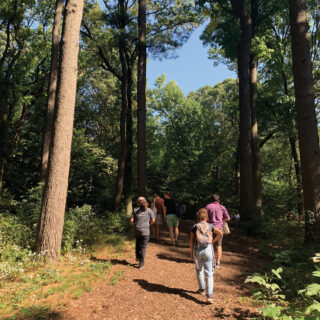Lee Altman, AIA, is the director of design management at SCAPE Landscape Architecture. She draws on her experience in city government as well as on her past work with architects, artists, scientists, and public health professionals to form a multifaceted perspective on the built environment.
In her essay “Reciprocity” (published in All We Can Save, an es-say collection edited by Ayana Elizabeth Johnson and Katherine K. Wilkinson), ecologist Janine Benyus describes two opposing ecological theories—competition and collaboration—that have evolved over the past five or six decades. The first proposes that a species benefits from the elimination of competition from other species that strive for the same resources, such as sun, water, and nutrients. The latter perspective posits, and ultimately proves, that plant communities have evolved over eons to support each other through cooperative or reciprocal relationships, facilitating and nursing robust growth. In Benyus’s words, “to read these strategies is to discover a manual for how life evolved on a challenging planet, and how natural communities heal and overcome adversity—essential reading for a climate-changed world.” Borrowing this perspective to reflect on the practice of architecture, landscape architecture, and other disciplines impacting our built environment could potentially help us develop more resilient practices, collaborations, and environments.
Early in my architecture career, as well as in my architecture and urban design education, I was taught that architecture is not only about the creation and articulation of space, but also about the facilitation and manifestation of process—that our role as architects is to orchestrate the different disciplines involved in design and construction toward what we believe to be the best outcome. To the extent this means that architecture is, or should be, an inherently collaborative process, I believe this premise still holds true. It does, however, position the architect at a vantage point that is somewhat removed from other disciplines, not to mention the communities and stakeholders affected by our work. If we are not careful, this premise can lure us to believe that we not only orchestrate, but also can become (or replace or override) planners, landscape architects, or ecologists without the necessary knowledge and training required for these specialized fields, and deny our projects the perspective these experts would otherwise offer.
I have spent the past several years working at SCAPE, a landscape architecture and urban design practice, first as a project manager and currently as a director of design management. Most of our projects are done in collaboration with other disciplines, many of them with architects. This has allowed me to participate in and lead many different projects and pursuits and engage with various architecture and engineering firms with vastly different approaches to practice.
One of the most prominent and defining differences among firms and disciplines has to do with time and the conceptual approach to when a project happens. This manifests in a few ways. More often than not, architecture projects culminate on “opening day.” Whether it’s receiving a Temporary Certificate of Occupancy, holding a large celebratory event, or simply opening the doors, it is the day on which the building or buildings are ready to be used, experienced, and enjoyed. Of course, the users are those who make the spaces their own, enliven them, and modify them over the life of the building, but, in essence, the building has taken its final form. This is often not the case with landscapes. Parks, streets, plazas, and other open spaces are rarely in their final form on opening day. It will take years, maybe decades, for landscapes to reach a form close to the one they were designed to meet, for the simple reason that landscapes grow. As a colleague likes to remind me, it takes 100 years to grow a 100-year-old tree. It takes time for those reciprocal relationships to establish, for environmental collaborations to build, and for a new piece of landscape to become part of our larger urban ecosystem. Landscapes should not be designed toward a specific point in time, but rather be conceived as a process.
It may be for this reason—though I suspect it has more to do with the everyday constraints of project schedule and budget—that some of our architect collaborators see landscape as an afterthought. Too often in our practice, landscape architects are brought into the project after decisions have already been made about building massing, circulation, and other key programming aspects. At this point, the landscape architect is expected to either color the leftover spaces green or to solve practical and performative needs, such as stormwater management, with little adequate space or technical flexibility.
In our more successful collaborations, architecture, landscape, and urban design are an integrated whole, working to set goals, identify priorities, and chart a roadmap for the project as a process from its onset. Programming, circulation flows, and spatial hierarchies work better and more seamlessly when conceived with multiple perspectives in mind. The projects that grow out of these collaborations are more resilient and versatile—more successful and meaningful for our clients and users, but also for the environments beyond. It is our responsibility to pursue these deeper collaborations, not only so our individual projects function, perform, and look better, but also so the larger urban ecology we all rely on can continue to be there to sustain and support us.
In accordance with Janine Benyus’s essay, studies have shown that reciprocal, collaborative relationships grow stronger, not weaker, in times and places of crisis. In fact, as she emphasizes, “the more stressful the environment, the more likely you are to see plants working together to ensure mutual survival.” Facing the extreme shocks and ongoing stressors of climate change, we could all stand to learn a thing or two from plant communities.








